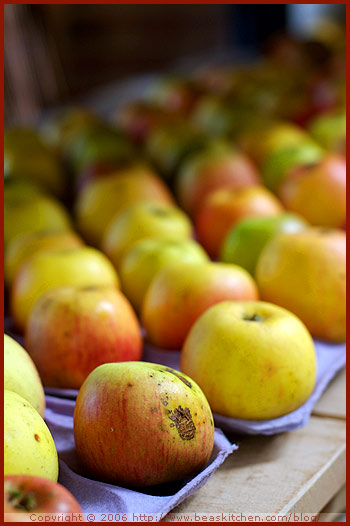
What do you do with so many beautiful apples? You cannot only think about apple pies and cakes. There is more to it!
The Apple Story — L’histoire des pommes
G.: — On doit se dépêcher, on va être en retard !
(We should hurry up, we are going to be late!)
Me: — Je ne suis pas sûre, ça ne doit pas seulement commencer à quatorze heures ? On a le temps.
(I am not sure, isn’t it supposed to start at 2pm only? We have some time.)
Back from Germany for a morning shopping in Sarrebrucken — which is only one hour away from my parents’ place — G. and I are keen to meet my brother B. We are meeting in Cappel, a tiny village close by where nothing special seems to happen, except for one event which I am really looking forward to witness.
“Prends la deuxième à gauche, c’est là.” (Take the next one on the left, it is there), G. tells me.
We drive the short road nearly to the end, and arrive at the cooperative where my brother and G. come every year. But not alone. This is the place where they bring their own apples to make apple juice.
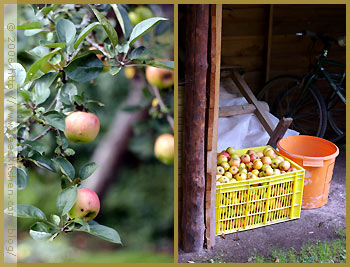
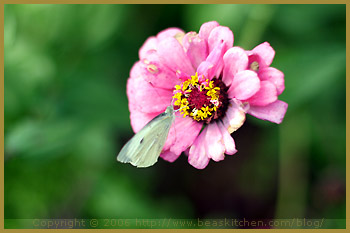
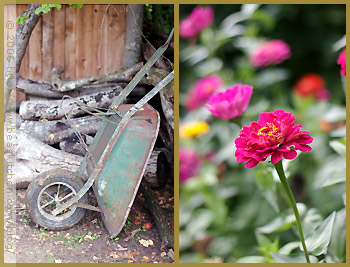
The cooperative is run by volunteers from the village to accommodate the many people who come from villages around to make their apple juice. As opposed to other places that provide the same service, this one offers people the ability to get the juice from their own apples. The connection between your own fruit and drinking its juice is really special, and B. has a strong tie to this being done with way. I quickly understand why. The apples from his orchard used for the juice — two old apple varieties, Reinette and Rambour — are simply delicious.
When I see the large bags that B. brings out of the car, I wonder how many bottles they are going to get from them. He has a lot of apples! A sign at the entrance of the cooperative indicates that we have to drive to the back of the building to drop the crates of empty bottles and the bags of fruit. From the peak I have inside the small building, I get a sense that it could be a laboratory. There is definitely a clinical look to it, with white cold-looking tiled walls and floor, people dressed in long aprons, wearing tall Wellington boots and blue-protecting gloves. But everyone smiles and talks loudly. Une ambiance bon enfant. “C’est un vrai poulailler ce matin !,” a woman tells me as she walks briskly by me, mimicking people who talk louder with her hand (It is like being in a hen house this morning). The noise of the machines does not help either.
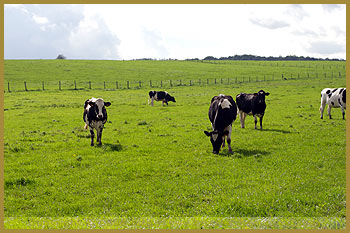
My brother tells me that the whole process takes little time, and he is right. The steps to make apple juices are simple and well organized. Everyone has a task to perform and things move quickly.
Step 1 — Drop the bags of apples in a large hollow container of a first machine in which the apples will be washed and crushed.
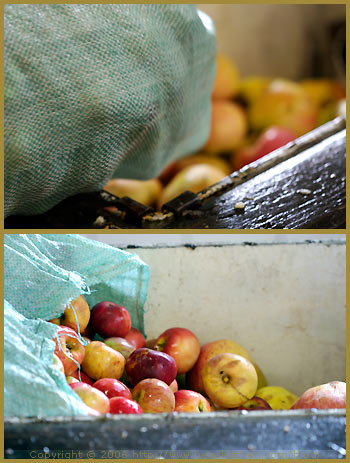
Step 2 — The flesh from the apples is extracted and dropped on flat pieces of framed wood which two people cover with pieces of jute fabric before placing another frame on top. They are compressed to extract the juice.
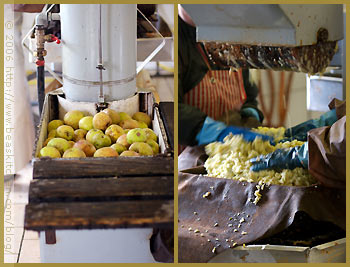
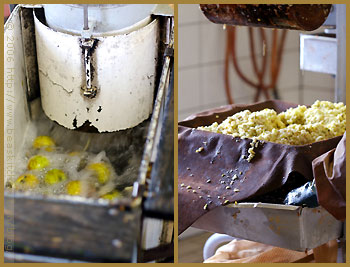
Step 3 — The apple juice is sucked into large labeled white containers through thin pipes.
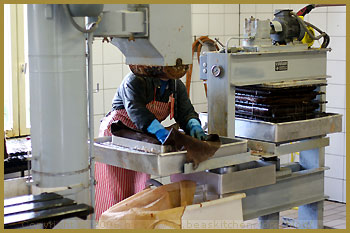
Step 4 — It goes in a juice extractor so as to remove the impurities.
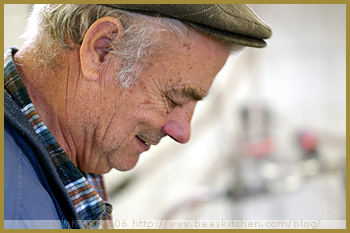
Step 5 — The juice is sucked again into a set of other white containers where it will be heated to 150 F (70 C), to provide un flash de pasteurisation (quick, light pasteurization).
Step 6 — At the other end of the chain, people place the empty bottles used for the fruit juice on a moving belt. They are kept warm by thin but strong streams of water projected on them, to avoid a large temperature difference between the glass and the warm juice. Without this step, the bottles might explode.
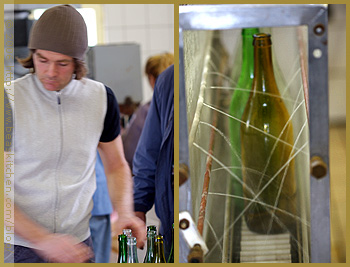
My brother placing bottles on the moving belt
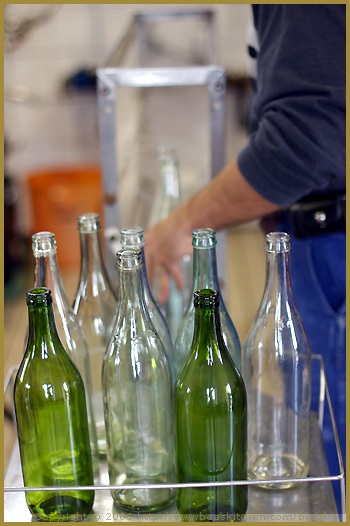
Step 7 — One person is in charge of placing the bottles one next to the other for them to be filled.
Once this is done, they are closed with a metallic cap similar to the ones used on bottles of beer.
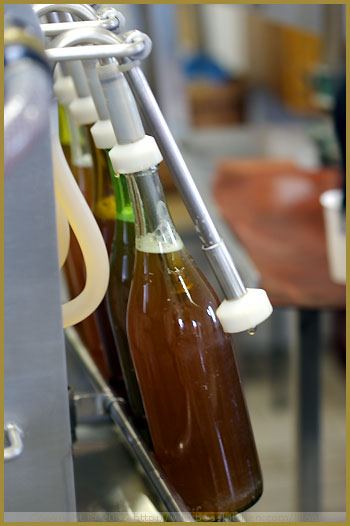
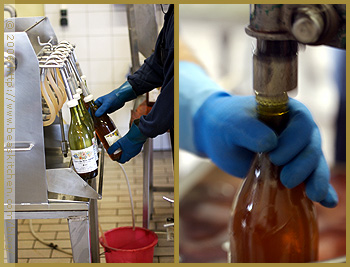
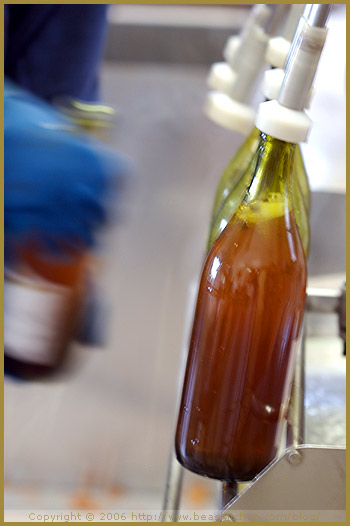
Step 8 — The bottles are placed in the crates and the whole process is completed.
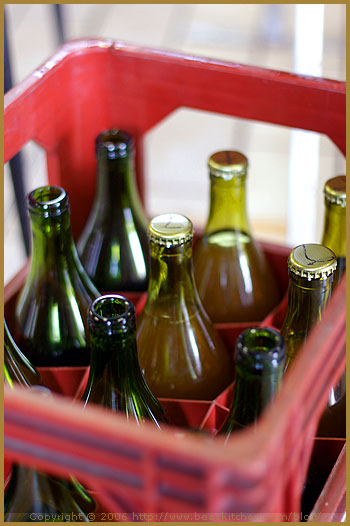
Time involved?
About an hour.
Cost involved?
For 54 liters, 25 Euros, about US$32.
When B. hands a glass of the juice for us to taste, we are far from imagining the world this innocent drink will enable us to enter. It is still warm, but I do not care. The apple juice is not clear, and I like that a lot. Comme de la brume dedans ! (Like mist inside!) I close my eyes and savor every single sip, imagining I am lying on my back at the foot of B’s apple trees, on a lazy Indian summer day. The smell is really strong and I wish it never ended.
This apple juice can be kept for about four years maximum, but I already know that it will not last for even one, in view of the speed by which we drink it. I only wished I could have taken some with me, back to Boston. Once more, I hate these agricultural restrictions.
So I promise to myself: one day, I will have to have mon verger à moi (my own orchard). This apple juice is just like nothing else!

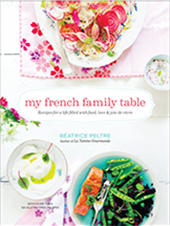
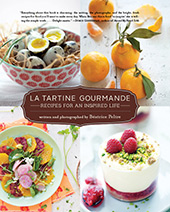
Oh mon dieu! Qui n’a jamais goute du jus de pomme fraichement presse a vraiment manque quelque chose, tu me fais venir l’eau a la bouche rien que d’y repenser.
ahhh…bea tu as beaucoup de chance…drinking an apple juice when you know exactly what was in it and how it was done. Thanks for sharing this.
As usual lovely pictures…
tout devient si beau et si épique avec toi ! et combien de personnes faut-il pour produire ce jus : ils ont tous l’air si concentrés !
What a wonderful post! Such a sense of place and the season. I love educational photo essays like this and now I know how apple juice is made. Makes me thirsty!
Quelle expérience magnifique ! Tu en as de la chance de pouvoir boire ainsi du jus fraîchement pressé des arbres de ton frère. Merci pour ce partage.
your post reminds when i visited a local orchard last year. In the middle of suburbia was this incredible orchard where the farmer grew heirloom varieties. he had a wonderful (and secret) formula for his fresh “apple cider” it was barely pasteurized (via UV light) and the taste was incredible. I can hear the conveyor belt and presser humming. What flavor! Beautiful photos, thanks for conjuring memories, Bea!
Bea, what a great story. I had the “fresh” apple juice you can buy at some of the supermarkets and I thought it was out of this world but I can only imagine how good just juiced Reinette and Rambour apples are! Today, in America, it seems like fruits are grown to be big,look good, and taste sweet with flavor coming in a distant 4th. Thank God I live in California where there are some small growers who take pride in offering a produce that aren’t all about looks!
Very nice and interesting post and your photos are beautiful.
This must be the best apple juice on earth. Lucky girl!
C’est très intéressant ce reportage et joli clin d’oeil à ton frère !
Bea – you brought back some lovely childhood memories:) My grandma had a huge orchard, and every August/September we spent few weekends making apple juice the old fashioned way. We had one of those wooden juice press thingies, and we were asked to help to wrap the chopped apple mush into muslin and then the grandpa would extract/press the juice out..
Shop-bough apple juice simply doesn’t compare with the real thing..
Etant particulièrement limitée en anglais, je ne peux que juger les photos, très pédagogiques et encore une fois merveilleusement belles. Merci pour ce beau reportage Béa 🙂
fresh apple juice, delicious! think I’ll go out and get some today 🙂
Thank you so much for the lovely story.
Wonderful. Luckily living in the state of apples(Washington) we have great apple juice and cider.
One of the best posts ever!!! I loved looking at the pictures so much. Thank you for taking the pictures and sharing it all with us.
Tu m’en offres un verre? Tu es très lucky d’avoir pu prendre part à cela!
Je pensais parler anglais !!! dommage que je me sois rendu compte que finalement je lisais seulement tes traductions… remarque tes images parle un langage que je connais !
You take gorgeous photos. I felt like I was right there with you. Wonderful post!
Bea, I love how your photograph!! You truly capture the whole process, it’s so personal and not in that textbook type of way, if you get what I mean. This is why I love your blog.
Bea this is so cool!
Being able to do that, take your own apples to be juiced, how I wish I could do that… and it’s bottled in glass too! Everything is plastic here in “clean, green, NZ” as apparently it’s “too expensive to clean glass” 🙁
Making your own apple juice! How cool is that!!! Now tell me, how about making your own apple brandy? I think it would be a match to Strega. Kinda like something SnowWhite would make no? 😉
Accch! So that means that if I do a Control+F for “in the fridge”, I won’t find apple juice? Grrrr….
I love fresh apple juice!!
Merci Gracianne, oui tu as bien raison, le meilleur !
Relly, thank you!
B, trop gentil de ta part. Oui c’était du travail bien efficace! 😉
Lisa, thanks so much. I am glad you enjoyed it.
Anne-Sophie, merci à toi.
Vanessa, this apple cider sounds delicious. Funny to hear the processes are similar across countries.
Gordon, thank you! I totally agree with you. I much prefer apples that are “what they are” rather than being calibrated and meant to look pretty to the detriment of taste.
Krista, thanks.
Anne, I know. I felt lucky!
Fabienne, merci.
Pille, ah this must have been so nice. You must have needed to squeeze hard for the juice to come out, right?
Lilo, merci à toi. Les images parlent d’elles-même, n’est-ce pas?
Kat, thanks! I hope you found some good one.
CakeBaker, thanks.
Peabody, yes I saw your beautiful apples while in WA state. You are lucky too.
Sher, thanks my dear.
Mitsuko, j’aimerais volontiers t’en offrir un verre, même deux, si je pouvais!
Dorian, ahah, tu es drôle. La langue du ventre, n’est-ce pas? On se comprend.
Natalia, thanks. I am glad you felt as if you were there.
Jenjen, thanks a lot. You are too sweet.
Bron, ah yes clean green NZ. But to tell you the truth, I like beautiful clean green NZ to stay this way! 😉
Rowena, ahahah, you cheeky one! I have to refill the fridge, wait!
Jeff, yes me too!
Hi !
J’admire votre sens de partage du fait decontribuer a’ la mise en commun de nos savoirs et experiences en vue d’ameliorer tant soit peu le quotidien des autres.
Je vis a’ Londres depuis pres de 6ans mais je pense que ma place est a’ cote de ces organisations ou missions qui luttent pour la pauvrete et la malnutrition dans le tier monde Je viens d’un pays ou’ la population est pauvre surtout a cause de manque de savoir faire dans tout les domaines tenez au congo par exemple 40% de la recolt fruitiere est gaspiller par manque de methode de conservation, or s’ils saveaint ne fusse que trans former ces fruits en jus par methodes artisanales .
Hi, my name is Ana Ferreira, i live in Terceira azores, Portugal, i run a small farming family business (apples).
I saw the artchive about “Making Artesanal Apple Juice”, i am interested in doing. If possible can i have some information (contacts) on the machines (where can i buy) or how can i go about finding that out.
My email is ilhabrumaterceira@hotmail.com
sincerely,
Ana Ferreira
What about Oranges!!
comment se passe la pasteurisation? Et une fois le jus pasteurise, le jus est-il denouveau en contact avec l’air ou directement en bouteille? merci. corinne
Pingback: Seasonal Apple Cake — Le gâteau aux pommes saisonnier by La Tartine Gourmande
Pingback: Homemade Applesauce | Food & Life
Pingback: Simplicity with Apples — Simplicité et des pommes | La Tartine Gourmande
Your writing is beautiful! What a treat you bestow upon the world.
Pingback: Good morning bircher muesli | La Tartine Gourmande